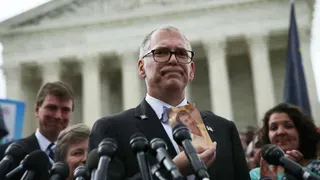October 4, 2012
Kickstarter Gives LGBT Entrepreneurs a Leg Up
Angela Giampolo READ TIME: 4 MIN.
Have the days of entrepreneurs sweating heavily and pacing while awaiting the arrival of potential investors passed us by? It sure looks that way. Thanks to crowdfunding websites like Kickstarter, which connects creators and donors with the click of a mouse, the only things required to bridge the gap between great ideas and final products are access to a computer and an Internet connection. For L.A. filmmaker Brian Speigel, getting together $10,000 to film a documentary on HomoClimbtastic, an international group of gay and lesbian rock climbers, was as easy as starting an account. He met his goal on July 14, and to date, has received $11,886.
"It took me about 25 days to raise up to the amount I was going for," Speigel told EDGE, saying Kickstarter was simple to use, and drew a lot of attention. "You can choose whether you get emails or not regarding who sets you up as a backer, and you don't have to email those people through your personal email. You can do it through Kickstarter to say 'thank you' and 'you should tell your friends about us.' It was crazy how many people looked at it not even through me, but just through the site itself. The people weren't friends or family. It's good for exposure."
Essentially, crowdfunding websites make it possible to harness the combined effort of individuals who network and pool their resources to bolster efforts initiated by other people or organizations.
To say that Kickstarter has been successful would be the understatement of the year. While Kickstarter set out with a humble goal to help get creative projects funded, it has far surpassed even its own expectations by morphing into a technology start-up funding powerhouse. The site was founded on two basic concepts: 1) "a good idea, communicated well, can spread fast and wide" and 2) "a large group of people can be a tremendous source of money and encouragement." It sounds simple enough.
But since its birth in 2010, Kickstarter has gone above and beyond, not only raising the amount needed for the projects posted by users, but also actually raising more than some projects' required amounts. In one example, Casey Hopkins, a designer, used Kickstarter to raise $75,000 in his quest to create a luxury iPhone dock out of solid aluminum. He wound up receiving $1.4 million.
And if you visit Speigel's homepage, you'll see a video and some text pitching the project. But you'll also notice that with each pledge comes some sort of tangible reward. This is one of Kickstarter's unique fundamental elements that helps to attract and net potential backers.
For example, Speigel offered to give anybody who donated $10 to his film a "thank you" in the movie's credits. Backers who contributed $600 or more were invited on a one-day outdoor climbing trip with Speigel, an executive producer credit, a DVD of the finished product and a disc of photos and footage that did not make the final cut. Additionally, all Kickstarter backers are assured that their money will be properly utilized; the company will not even release backers' funds to creators unless the project is fully funded.
Innovation Funding Innovation, For Artists
Kickstarter is a great resource, but it is only meant for creative projects like Speigel's -- the ideas of artists, musicians, designers, writers, illustrators, explorers, curators, performers and others. It does not cater to organizations that aim to solicit donations to causes, charity projects or general business expenses. Additionally, it outlines what is required of projects before they can be posted on the site.
Kickstarter defines a project as something "finite with a clear beginning and end." Further, it emphasizes that someone must be held accountable for the framework of the project, with respect to whether or not it was completed, within defined expectations. All of these restrictions, which really aren't very restrictive at all, serve to inspire the kind of backer confidence in Kickstarter that its users most crave.
In exchange for these services, Kickstarter takes only a modest amount: 5 percent of the amount raised (about the same amount Amazon charges for credit card processing fees). If the amount is not fully funded through the site, Kickstarter does not take anything. And more importantly, Kickstarter takes no percentage of ownership or intellectual property value in the creator's project -- the creator is entitled to keep 100 percent of the ownership over their project.
Through policies like these, Kickstarter has given entrepreneurs the security and confidence to campaign for their projects, while simultaneously inspiring backers to comb the site for worthy investments and fun rewards. In a nutshell, Kickstarter is innovation funding innovation -- exactly the kind of medicine needed to "kickstart" the economy and restore the American dream. It helps get ideas off the cutting room floor and out into the world. Speigel's movie is a great example.
"The editor is finishing up editing as we speak. The final cut will be done in the next few weeks," said Speigel of his documentary. "I'm submitting it to Sundance, and I'm going to South by Southwest as well. Then I'm trying to find some sort of distribution. We'll see how people can see it. It was a really important project for me. More of a labor of love than anything."
For more information, visit www.kickstarter.com/
Angela D. Giampolo is an attorney, avid entrepreneur, and advocate for the LGBT community. Her column informs readers about changes affecting the LGBT community and provides expert advice on varying topics. As Founder and Principal of Giampolo Law Group, her goal is to provide a safe place for the LGBT community to service their legal needs and have their business and entrepreneurial questions answered. To learn more about Giampolo Law Group visit www.giampololaw.com and to read more articles, you can visit the firm's two blogs at www.phillygaylawyer.com and www.lifeinhouse.com. To contact Angela directly with your business and legal related questions email her at: [email protected].





